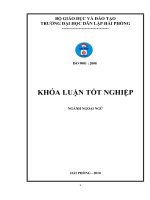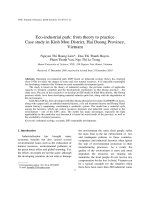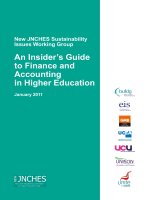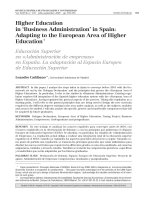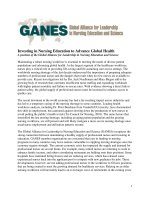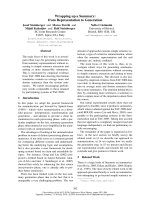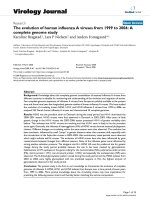Giving a lecture from presenting to teaching (effective teaching in higher education)
Bạn đang xem bản rút gọn của tài liệu. Xem và tải ngay bản đầy đủ của tài liệu tại đây (1.21 MB, 188 trang )
Giving a Lecture
This handy guide uses a multi-disciplinary approach, based on sound
educational theory, in order to give straightforward and practical advice to
the new and practising university or college teacher.
Jargon-free and refreshingly accessible, Giving a Lecture is the perfect
companion for the tentative, inexperienced, or simply busy lecturer looking
for a boost in ideas and inspiration. Its compact yet comprehensive
coverage of the subject tackles such crucial areas as:
■ the definition of a lecture, and how it should be used to support
student learning;
■ the needs of a lecturer;
■ preparation and handling nerves;
■ the best ways to structure and organize material and aids;
■ stretching the potential of a lecture as a teaching vehicle.
The book will be an instant requisite in further and higher education
settings, especially for new and part-time lecturers, tutors, and postgraduate teaching assistants, and will be an essential companion for anyone
engaged in staff development programmes.
Kate Exley is an Educational and Staff Development Consultant and Tutor
at the University of Nottingham. Reg Dennick is Assistant Director of
Medical Education, University of Nottingham.
Key Guides for Effective Teaching in Higher
Education Series
Edited by Kate Exley
This indispensable series is aimed at new lecturers, postgraduate students
who have teaching time, graduate teaching assistants, part-time tutors and
demonstrators, as well as experienced teaching staff who may feel it’s time
to review their skills in teaching and learning.
Titles in this series will provide the teacher in higher education with
practical, realistic guidance on the various different aspects of their
teaching role, which is underpinned not only by current research in the
field, but also by the extensive experience of individual authors, and with a
keen eye kept on the limitations and opportunities therein. By bridging a
gap between academic theory and practice, all titles will provide generic
guidance on teaching, learning and assessment issues which is then
brought to life through the use of short illustrative examples drawn from a
range of disciplines. All titles in this series will:
■ represent up-to-date thinking and incorporate the use of communication
and information technologies (C&IT) where appropriate;
■ consider methods and approaches for teaching and learning when there
is an increasing diversity in learning and a growth in student numbers;
■ encourage reflective practice and self-evaluation, and a means of
developing the skills of teaching, learning and assessment;
■ provide links and references to further work on the topic and research
evidence where appropriate.
Titles in the series will prove invaluable whether they are used for selfstudy or as part of a formal induction programme on teaching in higher
education, and will also be of relevance to teaching staff working in further
education settings.
Other titles in this series:
Assessing Students’ Written Work
–Catherine Haines
Small Group Teaching: Tutorials, Seminars and Beyond
–Kate Exley and Reg Dennick
Using C&IT to Support Teaching
–Paul Chin
iii
Giving a Lecture
From presenting to teaching
Kate Exley and
Reg Dennick
LONDON AND NEW YORK
First published 2004 by RoutledgeFalmer
2 Park Square, Milton Park, Abingdon, Oxon, OX14 4RN
Simultaneously published in the USA and Canada
by RoutledgeFalmer
270 Madison Avenue, New York, NY 10016
Reprinted 2004
RoutledgeFalmer is an imprint of the Taylor & Francis Group Group
This edition published in the Taylor & Francis e-Library, 2005.
“To purchase your own copy of this or any of Taylor & Francis or Routledge’s collection of
thousands of eBooks please go to www.eBookstore.tandf.co.uk.”
© 2004 Kate Exley and Reg Dennick
All rights reserved. No part of this book may be reprinted or
reproduced or utilized in any form or by any electronic, mechanical, or other means, now known or
hereafter invented, including photocopying and recording, or in any information storage or retrieval
system, without permission in writing from the publishers.
Key Guides for Effective Teaching in Higher Education web resource The Key Guides for
Effective Teaching in Higher Education Series provides guidance and advice for those
looking to improve their teaching and learning. It is accompanied by a useful website
which features brand new supplementary material, including How Students Learn, a guide
written by Professor George Brown which provides outlines and commentaries on theories
of learning and their implications for teaching practice.
Visit the website at: www.routledgefalmer.com/series/KGETHE
The RoutledgeFalmer website also features a wide range of books for lecturers
and higher education professionals.
British Library Cataloguing in Publication Data
A catalogue record for this book is available from the British Library
Library of Congress Cataloging in Publication Data Exley, Kate, 1964–
Giving a lecture: from presenting to teaching/Kate Exley
and Reg Dennick.
p. cm.
Includes bibliographical references and index.
1. Lecture method in teaching. I. Dennick, Reg, 1949– II. Title.
LB2393.E95 2004
378.1′796–dc22
2003018375
ISBN 0-203-46508-3 Master e-book ISBN
ISBN 0-203-47262-4 (Adobe eReader Format)
ISBN 0-415-30718-X (hbk)
ISBN 0-415-30719-8 (pbk)
vi
Contents
List of illustrations
ix
Series preface
xi
Acknowledgements
xiv
Introduction
1
1
Why lecture?
3
2
Preparing to lecture
15
3
Handling nerves, anxieties and discipline
problems
31
4
Structuring lectures
45
5
Using your voice effectively and presenting
material visually
63
6
Active learning in interactive lectures
83
7
Handouts
105
8
Computing and information technology in
lecturing
115
Student diversity
131
Evaluating lecturing
143
An outline of the legal position with regard to
supporting students with disabilities
159
Additional sources of information on specific
disabilities and support organizations
163
References
165
Index
169
9
10
Appendix 1
Appendix 2
viii
Illustrations
Figures
1.1 Constructive alignment
1.2 Bloom’s taxonomy for the cognitive domain
2.1 ‘Oh dear, did somebody book the small lecture theatre again?’
2.2 Suggested key topics to include in a first-year lecture on safety
2.3 ‘Now, what was I writing a lecture on?’
3.1 Keeping control of the shakes and jitters
3.2 The different faces of disruption
5.1 Finding your own style
5.2 Planning the use of board space
5.3 Making more of an impact with flipcharts
5.4 Using overhead transparency overlays
5.5 Diagram showing an example of a different viewing pathway of
material/information presented on a slide
6.1 ‘Hello back there’
7.1 An interactive handout used for the lecture on respiratory
failure (I)
7.2 An interactive handout used for the lecture on respiratory
failure (II)
8.1 ‘Beaming in from the beach’
9.1 ‘The advance of technology’
5
5
17
19
21
37
37
68
72
72
75
78
95
112
112
121
134
Tables
1.1
2.1
3.1
3.2
Mapping learning outcomes and teaching methods
What is the lecturing context? Key questions to ask
Common symptoms of nerves
Guidance from the University of Pennsylvania on correct
breathing technique
4.1 Final remarks—points a lecturer may wish to make at the end
of the session
6
16
32
35
60
x
5.1 Reasons to select different visual aids
5.2 An investigation into the use of graphics in visual aids
6.1 Introducing ‘active learning’ in lectures: common challenges
and possible ways forward
6.2 Using demonstrations in lectures
6.3 Tasks which students can undertake in a lecture
6.4 Suggested learning activities for students using interactive
handouts in lectures
8.1 The sequence of activities in peer instruction and class-wide
discussion
9.1 The required response and strategies outlined in the Code of
Practice—Students with Disabilities, UNSW
9.2 An agreement statement produced by the Office for Students
with Disabilities at the University of California, Los Angeles
10.1 QAA teaching observation form (I)
10.2 QAA teaching observation form (II)
10.3 Peer evaluation of teaching
10.4 A student evaluation of teaching questionnaire generated by a
central system (University of Nottingham)
A1.1 The QAA Code of Practice for Students with Disabilities
recommendations
70
77
87
91
93
97
119
133
136
150
150
150
155
161
Series preface
This series of books grew out of discussions with new lecturers and
part-time teachers in universities and colleges who were keen to develop
their teaching skills. However, experienced colleagues may also enjoy and
find merit in the books, particularly the discussions about current issues
that are impacting on teaching and learning in further education and higher
education (e.g. Widening Participation, disability legislation and the
integration of Communication and Information Technology (C&IT)
in teaching).
New lecturers may be required by their new institutions to take part in
teaching development programmes. This frequently involves attending
workshops, investigating teaching through mini-projects and reflecting on
their practice. Many teaching programmes ask participants to develop their
own teaching portfolios and to provide evidence of their developing skills
and understanding. Scholarship of teaching is usually an important aspect
of the teaching portfolio. New teachers can be asked to consider their own
approach to teaching in relation to the wider literature, research findings
and theory of teaching and learning. However, when people are beginning
their teaching careers a much more pressing need may be to design and
deliver an effective teaching session for tomorrow. Hence the intention of
this series is to provide a complementary mix of very practical teaching
tips and guidance together with a strong basis and clear rationale for
their use.
In many institutions the numbers of part-time and occasional teachers
actually outnumber the full-time staff. Yet the provision of formal training
and development for part-time teachers is more sporadic and variable
across the sector. As a result this diverse group of educators can feel
isolated and left out of the updating and support offered to their full-time
counterparts. At no time has there been so many part-time teachers
involved in the design and delivery of courses, the support and guidance of
students and the monitoring and assessment of learning. The group
xii
includes the thousands of postgraduate students who work as lab
demonstrators, problem class tutors, project supervisors and class teachers.
The group includes clinicians, lawyers and professionals who contribute
their specialist knowledge and skills to enrich the learning experience for
many vocational and professional course students. The group also includes
the many hourly paid and jobbing tutors who have helped full-time staff
cope with the expansion and diversification of HE and FE.
Universities sometimes struggle to know how many part-time staff they
employ to teach and, as a group, occasional teachers are notoriously
difficult to contact systematically through university and college
communication systems. Part-time and occasional teachers often have
other roles and responsibilities and teaching is a small but important part of
what they do each day. Many part-time tutors would not expect to
undertake the full range of teaching activities of full-time staff but may
well do lots of tutoring or lots of class teaching but never lecture or
supervise (or vice versa). So the series provides short practical books
focusing very squarely on different teaching roles and activities. The first
four books published are:—
■
■
■
■
Small Group Teaching
Giving a Lecture: From Presenting to Teaching
Assessing Students’ Written Work
Using C&IT to Support Teaching
The books are all very practical, with detailed discussion of teaching
techniques and methods, but they are based upon educational theory and
research findings. Articles are referenced, further readings and related
websites are given and workers in the field are quoted and acknowledged.
To this end Dr George Brown has been commissioned to produce an
associated web-based guide on Student Learning which can be freely
accessed by readers to accompany the books and provide a
substantial foundation for the teaching and assessment practices discussed
and recommended in the texts. The URL for this site is:
www. routledgefalmer.com/series/KGETHE
There is much enthusiasm and support here too for the excellent work
currently being carried out by the Learning and Teaching Support Networks
(LTSN) within discipline groupings (indeed individual LTSN centres are
suggested as sources of further information throughout these volumes).
The need to provide part-time tutors with the realistic connections with
their own disciplines is keenly felt by all the authors in the series and ‘how
it might work in your department’ examples are given at the end of many of
xiii
the activity-based chapters. However, there is no doubt some merit in
sharing teaching developments across the boundaries of discipline, culture
and country as many of the problems in the tertiary education sector are
themselves widely shared.
UNDERLYING THEMES
The use of Computing and Information Technology (C&IT) to enrich
student learning and to help manage the workload of teachers is a recurrent
theme in the series. I acknowledge that not all teachers may yet have
access to state-of-the-art teaching resources and facilities. However, the
use of Virtual Learning Environments, e-learning provision and
audio-visual presentation media is becoming increasingly widespread in
universities.
The books also acknowledge, and try to help new teachers respond to,
the growing and changing nature of the student population. Students with
non-traditional educational backgrounds, international students, students
who have disabilities or special needs are encouraged through the
government’s Widening Participation agenda to take part in further and
higher education (F and HE). The books seek to advise teachers on current
legislative requirements and guide on recommended good practice in
teaching diverse groups of students.
These were our goals and I and my co-authors sincerely hope these
volumes prove to be a helpful resource for colleagues, both new and
experienced, in HE.
Kate Exley
Acknowledgements
The authors of this book gratefully acknowledge the support, input and
encouragement that they have received from friends, colleagues and family.
Particular thanks to George Brown and Richard Blackwell for their
guidance and insightful suggestions during the writing of this book.
Steve Draper at the University of Glasgow and David Nicol at the
University of Strathclyde are thanked sincerely for their expertise and
willingness to share it, on the use of interactive handsets in lectures and
their impact on student learning.
The book has been framed with particular people in mind, i.e. the new
teachers who have attended our teaching and learning workshops in recent
years. Particular thanks are due to the occasional teachers at the London
School of Economics (LSE), the medical clinicians at the University of
Nottingham and the postgraduates who teach at De Montfort, Warwick and
Liverpool universities.
Special thanks must go to colleagues who have given their views and
told us about their approaches to lecturing from a wide range of discipline
areas. The list is by no means exhaustive but does include Liz Barnett, Liz
Sockett, Wyn Morgan, Stan Taylor, Stephen Griffiths, Paul Francis, David
Pollack, Peter Mayer, Paul Chin, Peter Davies and Tony Short.
A big thank you to Mike Exley for the original illustrations in the book.
Sincere thanks, too, to Alison Foyle and Priyanka Pathak at
RoutledgeFalmer. Their knowledge of the process of writing and
publishing and their understanding of authors’ foibles made their help and
guidance invaluable.
Introduction
Lecturing is the cornerstone of many undergraduate courses and is believed
by many academics to be the only way that their subjects can now be taught
to increasing numbers of students. Many universities are spending
thousands of pounds in refurbishing lecture theatres and updating the
technological support and the provision of audio-visual equipment to make
this form of teaching more effective.
‘Lecturer’ remains the title of the university and college teacher and
many students expect to be lectured to. Teaching timetables, in the main,
continue to include the words ‘lecture’ rather than ‘large group session or
workshop’. However, many courses have gone through rigorous change in
recent times and in some cases the lecture, considered to be outmoded and
ineffective, has been removed. However, it is interesting to observe that a
couple of years down the line many tutors have ended up reintroducing the
lecture into their courses. For example, many problem-based learning
(PBL) courses were initially designed and structured to run without
lectures but, in some cases, student demand has led tutors to introduce
‘plenary’ sessions that are essentially lectures.
There is no doubt that we probably overuse lectures in many higher
education (HE) courses and some aspects of the curriculum cannot be
sensibly ‘covered’ in a lecture theatre. However, we argue in this book that
by clearly considering the strengths and weaknesses of this form of
teaching we can help ensure that it is used effectively and not simply used
because it is what we have always done (and what was done to us!).
The early chapters focus on the skills and techniques needed to write and
deliver material clearly and interestingly. There are many examples of
practice and clear advice is given. Much of the latter part of the book is
dedicated to improving the lecture. A range of strategies for broadening the
learning scope, breadth and depth of the traditional didactic lecture are
considered. The emphasis being to support the move from presenting to
teaching by encouraging students to participate and engage with the lecture
2 INTRODUCTION
material and thus increase the likelihood that deep learning can take place.
This does involve a considerable change in culture and a reappraisal of the
lecture from both teachers and students. The authors hope that this volume
holds some useful ways forward for many new teachers and maybe a few
experienced colleagues too.
In addition to ‘Further reading’, each chapter ends with a list of useful
websites. All websites referred to were functional at the time of going
to press.
Chapter 1
Why lecture?
THE HISTORY OF THE LECTURE
The lecture, presented to hundreds of students in a lecture theatre, is the
standard model of academic teaching. Academic staff in the UK are called
lecturers and readers, terms deriving from the Latin lectare meaning ‘to
read aloud’. The technique goes back many hundreds of years, to the
monasteries of Europe before the use of printed books, where scholars would
travel hundreds of miles to gain access to specific texts. In a scriptorium a
monk at a lectern would read out a book and the scholars would copy it
down word for word. One wonders whether much has changed since then
as the activity of copying down the lecturer’s notes is still one of the main
functions of lecturing in higher education.
Lecturing is the transference of the notes of the lecturer to the notes of
the student without passing through the brains of either.
(Anon)
Traditionally lecturing is often perceived by students as boring, with
little intellectual stimulation coming from monotonous lecturers.
Most people tire of a lecture in ten minutes; clever people can do it in
five. Sensible people never go to lectures at all.
(Stephen Leacock in Sherin 1995: 104)
In recent years a great deal of discussion has focused on the development
of ‘active learning’ in higher education (see series website guide, Brown
2004). Lecturing is often viewed as an example of ‘passive learning’ in
which the only activities students engage in during a lecture are listening
and note taking. Such lectures are often described as ‘didactic’ which
means ‘intending to instruct’, from the Greek, didaskein, ‘to teach’. Active
4 WHY LECTURE?
learning on the other hand includes activities such as discussion,
questioning, problem solving and other forms of interactivity, which are,
traditionally, not carried out during a lecture. As active learning has been
shown to encourage deeper learning there has been a move away from
lecturing to more small group teaching, self-directed learning and problembased learning. However, as student numbers have increased in tertiary
education and many universities have tried to resist the pressures of
increasing staff/student contact hours in order to protect research
productivity, there has been a recent increase in lecturing together with
other forms of large group teaching. How can these two very different
positions be justified? The view supported here is that lecturing need not
be passive and that there are a variety of different learning activities that
can be carried out by students during a lecture.
LECTURING AND CONSTRUCTIVE ALIGNMENT
The concept of constructive alignment (Biggs 1999b) suggests that a
curriculum should have a set of well-defined learning outcomes that are
acquired via a set of appropriate learning experiences. The learning that
has taken place is then assessed via a set of appropriately valid assessment
tools. The whole system is then evaluated via quality assurance processes
and modified if necessary, leading to a process model of the curriculum as
shown in Figure 1.1.
It is at the level of learning experiences that decisions need to be made
about the balance between different types of teaching methods. Different
learning outcomes are more appropriately acquired by different learning or
teaching methods. Learning outcomes can be categorized in a number of
ways. One method is to use Bloom’s Taxonomy (Bloom 1956) which for
cognitive objectives is shown in Figure 1.2.
A simplified categorization splits knowledge outcomes into three broad
categories:
■ factual and conceptual understanding
■ application and use
■ problem solving and evaluation.
The problem is then to decide which categories of outcome are more
appropriately gained using the various teaching and learning modalities
WHY LECTURE? 5
■ FIGURE 1.1 Constructive alignment
■ FIGURE 1.2 Bloom’s taxonomy for the cognitive domain
6 WHY LECTURE?
■ TABLE 1.1 Mapping learning outcomes and teaching methods
available in higher education. Table 1.1 indicates which of the common
modalities are more appropriate for which of the three outcomes.
Some teachers might argue that you can teach application and usage or
problem solving and evaluation in lectures. There is no doubt that students
in conventional lectures may observe the lecturer engaging in applying
knowledge and problem solving and even mentally engaging in the
process, so there is some cognitive gain. However, there is a big difference
between teaching about applying knowledge and problem solving and
learners actually applying or problem solving themselves. These activities
can be better supported in a small group teaching environment.
It can be seen that conventional lecturing appears to be ideally suited to
the acquisition of factual information and conceptual understanding.
However, it is very possible and probably desirable to create a richer
lecturing environment in which the students can carry out a variety of
active and interactive learning tasks. It then becomes possible for learners
to achieve many of the higher levels of cognitive and skills development
within the lecture.
Therefore, constructive alignment suggests that curriculum planners
should decide on the balance between different teaching methods and
modalities based on the learning outcomes of the curriculum. Clearly key
factual and conceptual outcomes will be more appropriately learned in
conventional lectures and higher cognitive outcomes may be best acquired
in a small group teaching session or partially achieved in an interactive
lecture. This situation also raises the question of the relative proportion of
key factual and conceptual outcomes there should be in the curriculum in
WHY LECTURE? 7
the first place. One of the problems of the modern curriculum, particularly
in the scientific and technical disciplines, is the exponential growth in
knowledge. This frequently manifests itself as increased facts, ideas and
concepts that have to be crammed into an ever-expanding curriculum. But
clearly this expansion cannot continue indefinitely. Decisions have to be
made on the size of the ‘core’ factual content of the curriculum and this
will clearly influence the number of lectures that will be required.
LEARNING STYLES
Another reason for curriculum planners to include lectures in the
curriculum, ensuring a balance with other teaching methods, is the issue of
individual learning styles. A number of psychometric tests reveal that
learners differ in their approach to learning. For example, Honey and
Mumford (1982) suggest that a learner’s learning style can be profiled
under four categories: activists, reflectors, theorists and pragmatists. The
four learning style categories map closely to the four quarters of the
experiential learning cycle proposed by David Kolb (1984): concrete
experience; observation and reflection; forming abstract concepts, and
testing in new situations, and indicate a preference for particular learning
activities. For example, learners who are strongly activist in their approach
will prefer learning contexts which allow them to ‘learn by doing’ whereas
pragmatists appreciate learning in the light of a clear application and use
for their learning. It is important not to use such terminology to ‘label’
students and to recognize that learning styles are strongly influenced by the
learning context and that learners will both challenge and hone their
learning preferences during a course of study. (Please see the web-based
guide, Brown 2004, for a more detailed discussion of the theories of
learning underpinning these learning styles).
A well-known system of personality classification was developed by
Kathleen Briggs and Isabel Myers in the twentieth century based on Carl
Jung’s book Psychological Types (Jung and Baynes 1971). The
MyersBriggs Type Indicator reveals a, more complex, set of sixteen
categories (Myers-Briggs 2002). David Keirsey has developed and
redefined Myers-Briggs terminology and produced the Keirsey
Temperament Sorter (KTS) (Keirsey 1998). Here four basic dimensions of
temperament are presented: extroversion and introversion; intuition and
sensing; thinking and feeling, and judgement and perception. For our
purposes these different ‘indicator’ tests strongly suggest that within a
large group of students there will be a distribution of different learning
styles and different personality types which encourages the view that our
8 WHY LECTURE?
students will learn more or less effectively from different learning
situations. On these grounds it is therefore necessary to provide a variety
of learning situations so that all students have an opportunity to use their
preferred learning style at some time during the course.
COST-EFFECTIVENESS
It is frequently argued that lecturing is the most cost-effective way of
teaching students. One lecturer can teach hundreds of students in a large
lecture theatre. However, there is a huge conceptual difference between
teaching students, or ‘covering’ a topic as it is sometimes referred to, and
students learning the information presented. If all that was taught was
learned then it would be truly cost-effective, but it isn’t. Evidence suggests
that only 10 per cent of the words delivered in a lecture are recorded in the
notes of the students with only a small proportion effectively learned in the
short term and with long-term retention significantly reduced (Johnstone
and Su 1994). In addition, as previously discussed, the nature of what is
learned in conventional lectures is usually only of the factual and
conceptual understanding variety; higher cognitive outcomes tend not to
be acquired.
However, the arguments surrounding cost-effectiveness usually refer to
conventional, passive, didactic lectures; interactive lectures in which the
students are encouraged to actively engage with the lecture material, to be
described later, can result in a greater level of understanding.
WHAT CAN THE ‘TRADITIONAL’ LECTURE
DO WELL?
The teaching tips given to teachers in the School of Sciences at the
University of Staffordshire summarize a commonly held view of the
traditional lecture and list the strengths associated with it.
Five reasons for giving lectures
1. Communicating enthusiasm for the topic. This is the best reason for
delivering lectures as it is one of the few features that cannot be gained
by independent learning.
2. Providing a structure or framework for the material. A lecture is a
good format with which to impose a certain emphasis on the material
that students will read about. This might be desirable for a number of
reasons. You might wish to emphasize certain points of view (maybe
your own), raise issues that will shape the students’ thinking about the
WHY LECTURE? 9
topic, relate the topic to others in the course, explore practical
applications of the central ideas, and so on.
3. Tailoring material to the students’ needs. Experience might tell you
that the textbooks for a topic do not cover the material in sufficient
depth or at the right level for your audience. In this case, lectures can
serve to ‘part digest’ the material so that students will be better able to
extend their learning using books and other sources. It might also be the
case that all of the material you want to cover is not available together
in one external source.
4. Providing current information. However good the available
textbooks and other resources are, they are rarely going to be
absolutely up-to-date and, in any case, will not remain so for long. The
lecture provides an opportunity to present recent research to students.
This may include your own current work or even ideas you have for
research that it would be good to conduct.
5. Using another format is not viable. This is often the case when you are
faced with large student numbers. It is, of course, true that giving a
lecture is more cost-effective than repeating a small group seminar a
large number of times. However, there may also pedagogic grounds
for rejecting other formats.
(Staffordshire University, Teachign and Learning
webpages, />learning_and_teaching/LTMlect.htm)
THE CRITERIA FOR INCLUDING A LECTURE IN
THE CURRICULUM
The discussion above implies that conventional lectures should be focused
into particular areas of the curriculum and should only occur when specific
conditions are met. The most important are listed and explained below.
Clear overview
■ A lecture should be an overview of a key area of knowledge delivered
by someone knowledgeable in the field who understands the problems
and potential misunderstandings that can occur.
■ The lecturer should have refined and processed the information to be
presented and should have ensured that it is useful and relevant in terms
of overall curriculum outcomes.
10 WHY LECTURE?
■ The lecturer should be able to provide added value in terms of
simplified explanations of complex concepts that go beyond what might
be found in conventional textbook presentations of the subject.
■ The lecturer should be aware of the level and stage of the students and
should adjust content and explanations appropriately.
Controlled factual content
■ The amount of material presented should be strictly controlled and
should fit within the overall curriculum outcomes of the course.
■ The lecture should focus on the core themes and central arguments and
information and should limit the amount of detail and the number and
obscurity of examples used.
■ If necessary further information can be provided in handouts or in the
recommended reading suggested.
■ The lecturer does not have to ‘cover’ everything in the lecture.
Informed and enthusiastic lecturer
■ Lecturers should have had some basic training in lecturing
and presentation skills and should be competent to use a range of
audio-visual aids.
■ They should be able to structure and organize a lecture and have good
time-management awareness.
■ Lecturers should demonstrate enthusiasm for their subject and should
communicate this to their audience by means of an interesting and
stimulating presentation.
FINAL REMARKS
In summary, then, whether or not you choose to give a lecture should
depend on what you are trying to achieve. For the expedient transmission of
facts and information then the traditional, expository lecture format is
effective. When compared with more discursive forms of teaching there
are few possibilities for feedback, student questions and the development of
problem solving and higher order cognitive skills (Bligh, 1998). The
traditional lecture greatly benefits from being delivered by a
knowledgeable, prepared and, above all, enthusiastic teacher. Knowing
how to put a message across clearly, structuring material so that learners
can follow even the most complex arguments and explanations and using a
